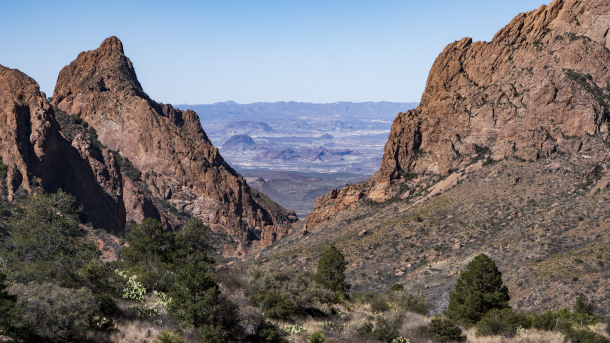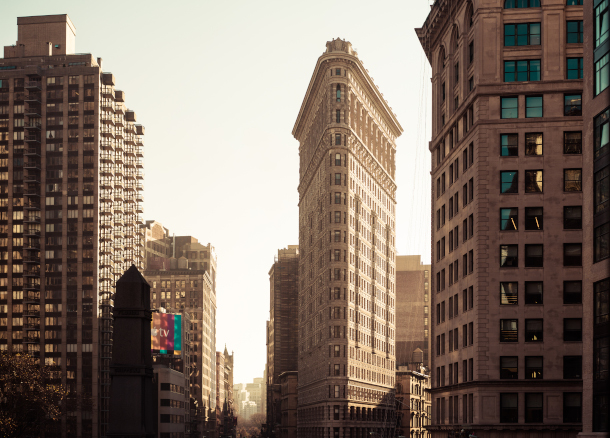From the History Books
Air Date: Week of June 14, 2024

The Chisos Mountains in Big Bend National Park. (Photo: Jonathan Cutrer, Flickr, CC BY-NC 2.0)
This week, Living on Earth Contributor Peter Dykstra joins Host Steve Curwood to look back on the 1944 creation of Big Bend National Park, renowned for its Chihuahuan Desert ecology and dark skies. They also go further back in time to the 1889 New York law mandating that all electric and phone lines in New York City and Buffalo be placed underground.
Transcript
CURWOOD: It’s Living on Earth, I’m Steve Curwood.
And on the line now from Atlanta, Georgia is Peter Dykstra, taking a look at the history books for us today. Hey, Peter, what do you see?
DYKSTRA: Hi, Steve. We see a couple of things. Going back first to June 12, 1944. Big Bend National Park is established in Texas. Located along the banks of the Rio Grande River. The park features absolutely undisturbed ecology of the Chihuahuan Desert. The park is also valued as a treasure trove of Native American artifacts and history.
CURWOOD: It is a pretty amazing place. They have a lot of endemic species, plants and animals, and great places to hike. And it's actually linked with natural areas across the border in Mexico. Maderas del Carmen, Cañón de Santa Elena, and Ocampo, which means that Big Bend is part of something like 3 million acres of Chihuahuan Desert resources. And one of the coolest things about it is that this is one of the best dark sky places in the United States, one of the best places for night sky viewing.
DYKSTRA: Absolutely. And there's so much to see in a truly dark sky. And a dark sky place literally in the middle of nowhere is, is one I wouldn't mind spending a little bit of time.
CURWOOD: Hey, from Big Bend, let's take a turn to another story.
DYKSTRA: And take a turn to another century, the 19th century with a really foresightful gesture by the New York State Legislature. June 14, 1889, New York voted to literally clear the air, outlawing overhead electric lines in its two largest cities, Buffalo and of course, New York City. All telegraph, telephonic, and electric light wires and cables must be placed under the surface of the streets, lanes, and avenues. Just in time for a boom in electricity and all the things that it brought us at the end of the 19th century.

New York City’s Flatiron Building, with nary an electrical pole in sight. (Photo: Victoria Pickering, Flickr, CC BY-NC-ND 2.0)
CURWOOD: Right. And it's protected New York City from losing electric power randomly when there's a big windstorm because, you know, when the wires are underground, they're not affected by the wind. And it's really made the place look a lot better. Just imagine for a moment a picture, say of the Flatiron Building. And there's no telephone poles in it. Almost any other city, if you see nice architecture, the photographer has to work around those, those wires and poles, but not in New York City.
DYKSTRA: Well, Steve, as you know, I grew up in a New York City suburb that, to this day, still has overhead wires helping to block the view.
CURWOOD: It was over 100 years ago that we had this insight, but some places are just plain behind the times. Hey, thanks, Peter. Thanks for these stories from the history books. And we'll be talking to you again real soon. Peter Dykstra is a contributor to Living on Earth.
DYKSTRA: All right, Steve, thanks a lot. Talk to you soon.
CURWOOD: And there's more on the stories from the history books at LoE.org.
Links
Learn more about New York City’s underground electrical grid
Living on Earth wants to hear from you!
Living on Earth
62 Calef Highway, Suite 212
Lee, NH 03861
Telephone: 617-287-4121
E-mail: comments@loe.org
Newsletter [Click here]
Donate to Living on Earth!
Living on Earth is an independent media program and relies entirely on contributions from listeners and institutions supporting public service. Please donate now to preserve an independent environmental voice.
NewsletterLiving on Earth offers a weekly delivery of the show's rundown to your mailbox. Sign up for our newsletter today!
 Sailors For The Sea: Be the change you want to sea.
Sailors For The Sea: Be the change you want to sea.
 The Grantham Foundation for the Protection of the Environment: Committed to protecting and improving the health of the global environment.
The Grantham Foundation for the Protection of the Environment: Committed to protecting and improving the health of the global environment.
 Contribute to Living on Earth and receive, as our gift to you, an archival print of one of Mark Seth Lender's extraordinary wildlife photographs. Follow the link to see Mark's current collection of photographs.
Contribute to Living on Earth and receive, as our gift to you, an archival print of one of Mark Seth Lender's extraordinary wildlife photographs. Follow the link to see Mark's current collection of photographs.
 Buy a signed copy of Mark Seth Lender's book Smeagull the Seagull & support Living on Earth
Buy a signed copy of Mark Seth Lender's book Smeagull the Seagull & support Living on Earth

